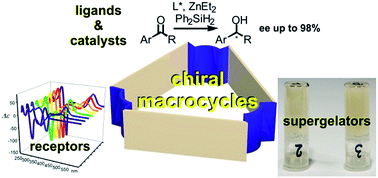Fine tuning of molecular and supramolecular properties of simple trianglimines – the role of the functional group†‡
Abstract
Chiral, triangular poly-azamacrocycles (trianglimines) readily available from enantiomerically pure trans-1,2-diaminocyclohexane and various aromatic dialdehydes, differ in their nature and substitution pattern. The highly symmetrical macrocycle having two electron-donating groups attached to the aryl moieties is formed under thermodynamic control that fulfilled the so called entropy of symmetry rule. Conversely, from the 2-nitroterephthaldehyde a kinetic product of trivial C1 symmetry is solely obtained, whereas from 2-methoxyterepthaldehyde a mixture of C3- and C1-symmetrical macrocycles are formed. The factors that contribute to the mechanism of the macrocycle formation were determined on the basis of an experimental/theoretical approach. The non-symmetrical structure of the macrocycle resulted from a symmetrical intermediate that appeared during cyclocondensation. The chiroptical properties of the trianglimines were studied by means of experimental ECD and VCD methods supported by quantum-chemical calculations. The nitro-substituted trianglimine appeared to be a simple, low molecular weight supergelator forming in polar media of stable chiral organogels. The structure of the gel is affected by the nature and chirality of the dopant. The hexaimine macrocycles after reduction of the C![[double bond, length as m-dash]](https://www.rsc.org/images/entities/char_e001.gif) N imine bonds formed trianglamines – useful chiral ligands in stereoselective synthesis. The Zn–trianglamine complexes were employed as catalysts for asymmetric hydrosilylation of prochiral ketones, providing products of enantiomeric excess up to 98%. This remains the best result obtained for Zn–diamine catalysed asymmetric hydrosilylation of ketones so far.
N imine bonds formed trianglamines – useful chiral ligands in stereoselective synthesis. The Zn–trianglamine complexes were employed as catalysts for asymmetric hydrosilylation of prochiral ketones, providing products of enantiomeric excess up to 98%. This remains the best result obtained for Zn–diamine catalysed asymmetric hydrosilylation of ketones so far.


 Please wait while we load your content...
Please wait while we load your content...